Around the World for money signs: a selection of interesting coins from around the world
Hi, Geektimes! In continuation of the topic of cash from different parts of the world, we present to your attention a selection of regular coinage coins. In search of interesting specimens, we went on a virtual world tour and visited all the “inhabited” continents.
Did we find something special, judge you. We only note that this review is not a rating and is based on the personal preferences of members of the editorial board. The starting point of our journey will be Russia. For clarity, the route of movement, we mapped.

Issue 1. How did world currencies get their names?
Issue 2. Rating of the most beautiful money of the world
Issue 3. Composite coins - an alternative to paper and metal
Release 4. Money of the XX century: a selection of bills, out of circulation
Issue 5. Around the World for money symbols: a selection of interesting coins from around the world
')
How Russian coins look, every Russian knows. But, perhaps, not everyone has heard that this year the Bank of Russia issued coins with an updated obverse. Earlier in the design was used the emblem of the Bank of Russia. The minting of coins with the image of an eagle without regalia began in 1992, when the national emblem of Russia was not yet approved.
On the new coins of all denominations, the Central Bank’s emblem replaced the image of the state emblem of the Russian Federation (this is a regular coinage, the emblem on commemorative coins could be seen earlier, for example, in the series devoted to the Sochi Olympics) - a double-headed eagle with regalia of power: crowns, a scepter and power. One such literally the other day came into my hands (on the left there is a coin with an old obverse, on the right - with a new one)
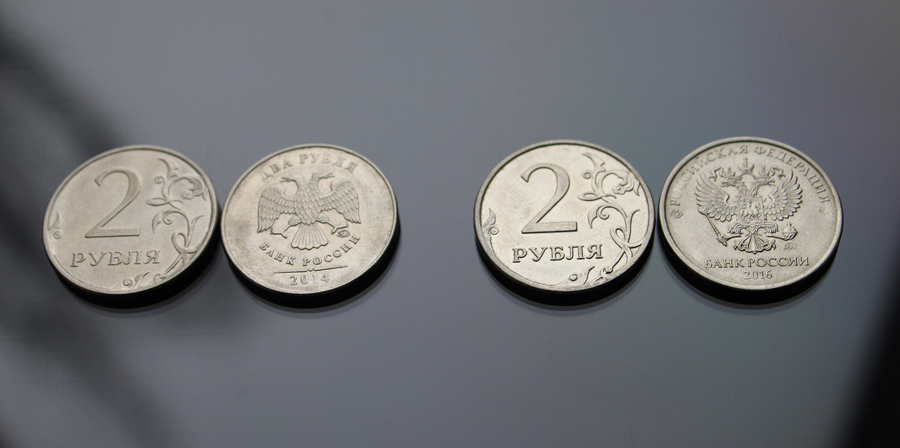
In my opinion, now the coin looks more elegant. Coins with an old obverse ("eagle") remain in circulation and "continue to be legal means of cash payment."
By the way, the national designation of the sides of the coin - “tails”, according to one of the versions, is associated with the advent of copper coins of the Empress Elizaveta Petrovna. The patterned interlacing of the royal initials was perceived by the illiterate population as a lattice.

But let's not delve into the story, we begin our journey. And first I propose to visit Denmark.
As a warm-up, consider the design of Danish coins, by the way, rather unusual for a European country.
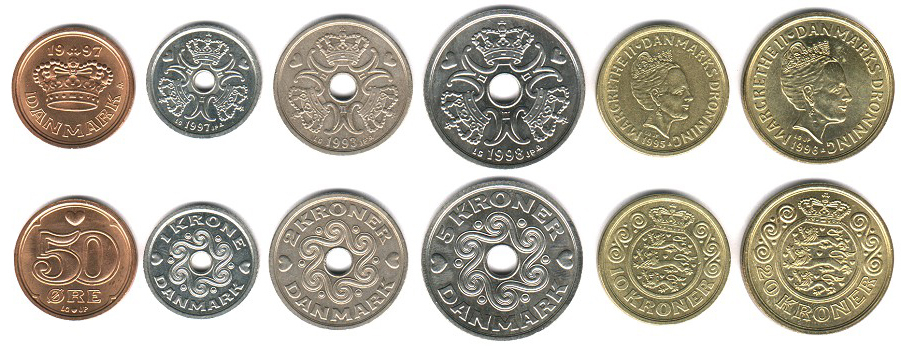
The photo shows coins 50 era, 1, 2, 5, 10 and 20 CZK. Coins in denominations of 1, 2 and 5 CZK with a hole in the center began to be issued since 1925 in order to simplify the life of the visually impaired. For the same reason, such coins are minted today. Holes differ in diameter, so they are very easy to distinguish.
Another interesting detail of Danish coins is the “hearts” in different parts of the coins. Such an unusual symbol is the sign of the Danish Mint. On coins of 50 era, 1, 2, 5 kronor, hearts are more noticeable, on coins of 10 and 20 kroner they are also present, but not so obvious and are located only on the obverse - among the inscriptions.
In the United Kingdom you can find coins of such denominations: 1, 2, 5, 10, 20, 50 pence, as well as 1 and 2 pounds. On the obverse of British coins traditionally depict the current monarch (now - a portrait of Queen Elizabeth II). As the queen ages, the portrait has changed, and now there are 4 different profile types:

Each subsequent royal person looks in the opposite direction to the previous one. The reverses of British coins are quite diverse. Until 2008, the Penns reverse depicted various symbols of the United Kingdom - the crowned porticulis (a descending lattice in the gates) of the Westminster Palace, a fragment of the coat of arms of Wales (3 ostrich feathers over the princely crown), the emblem of Scotland (the crown above the burdock flower) and others.

Since 2008, on the reverse of pennies, fragments of the shield of the royal coat of arms of Great Britain were depicted, and on the new pound coin - the entire shield.
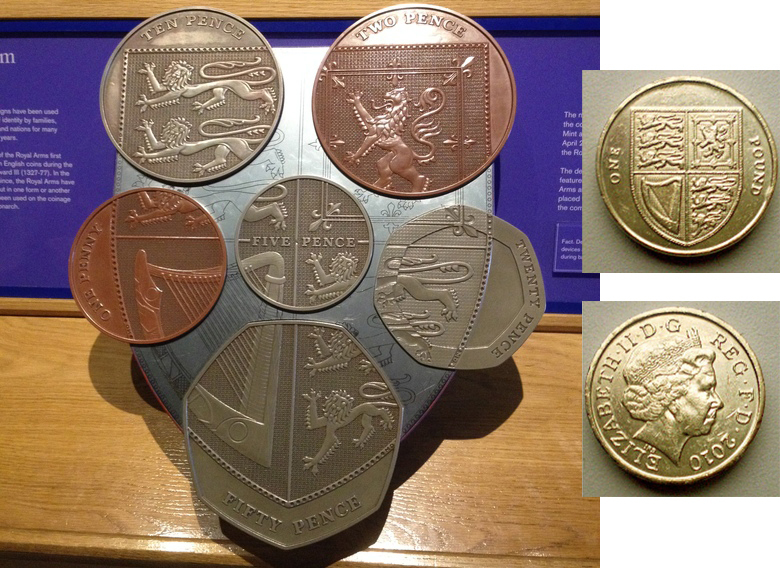
The latter, by the way, actually has no fixed reverse. Since the introduction of the one-pound coin in its current form in 1983, the reverse has changed annually (and sometimes twice a year). Each year, it places something corresponding to one of the 4 parts of the Kingdom - England, Northern Ireland, Wales and Scotland - plants representing parts of Great Britain - oak, flax, leek, thistle; heraldic elements - a rising lion, a walking dragon, a Celtic cross; famous bridges; fragments of coats of arms and others. Here are just some of the pound coins:
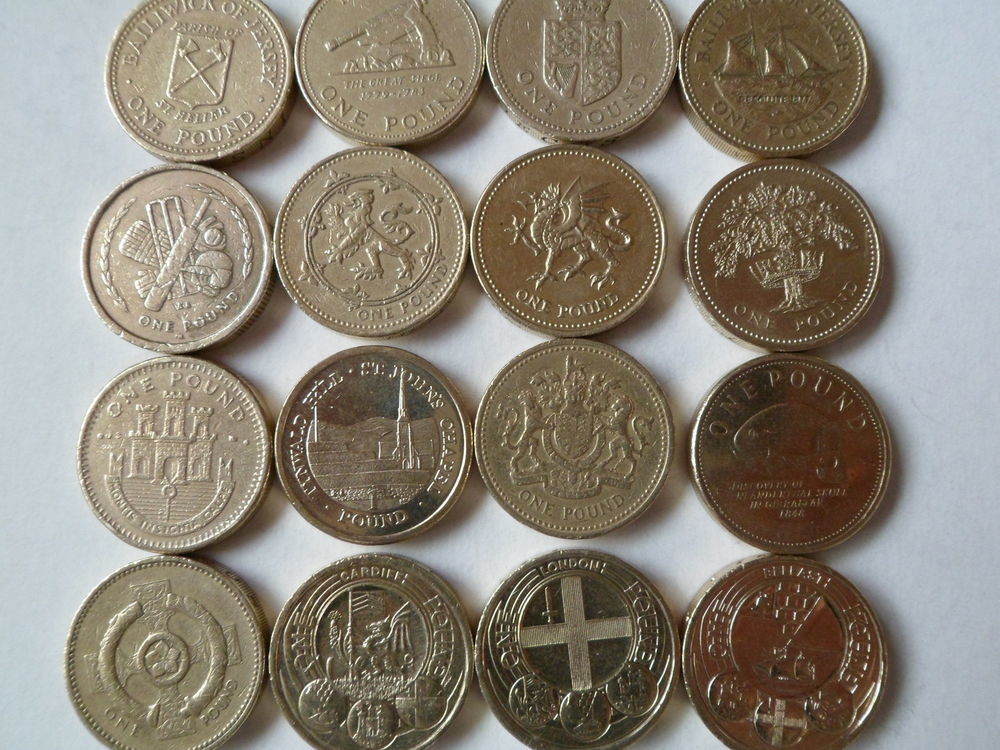
All of them are in circulation, which makes British numismatics rather difficult and costly.
But in Egypt, on the contrary, a set of coins of regular coinage is quite limited. In the course of the coin in denominations of 25, 50 piastres and 1 pound. Two more - 5, 10 piastres, although they are legal means of payment, but practically do not occur in circulation.

The obverse of the coins (with the exception of 25 piastres) shows thematic pictures: a vase in classical Arabic style, the mosque of Mohammed Ali, which is located in the Cairo citadel, a portrait of Cleopatra, the funerary mask of Tutankhamun. 25 piastres — perhaps the most uninteresting of Egyptian coins — contain only inscriptions — the denomination and name of the state جمهورية مصر العربية (“Arab Republic of Egypt”). On the reverse of all coins - denomination in Arabic and in English.
The next country we go to is Suriname, a state in northeastern South America. Local coins are primarily interesting face value. In the course of 1, 5, 10, 25, 100 and 250 cents.
On the obverse of the coins in the frame of floral ornament is the coat of arms of Suriname. On the coat of arms you can see two indigenous people holding a central shield. His left half with the image of the ship symbolizes the past, when slaves from Africa were brought to Suriname. The right side personifies the present, depicted as a palm tree (the symbol of a righteous person). The rhombus in the center of the shield indicates 4 directions of the world, and the five-pointed star - 5 continents and 5 large ethnic groups that make up the population of Suriname.

On the background of coins with a standard round shape, coins of 5 cents stand out - they are square, their corners are smoothly rounded.
Curaçao and Sint Maarten are self-governing public entities - 2 islands that are part of the Kingdom of the Netherlands . The Netherlands Antillean guilder, introduced into circulation in 1932, is recognized as the national currency. In 2012, the islands planned to switch to the Caribbean guilder, but after the introduction of the new currency was postponed indefinitely.
Almost all the coins of Curacao and Sint Maarten have a regular round shape. The only exception is a coin of fifty cents, made in the shape of a tetrahedron.

All cent coins have a similar design and embossing. On the reverse invariably minted face value in a circle with an ornament of sea shells and pearls. On the obverse - an orange branch with three flowers.
The reverse of the coins of 1, 2, 2.5 and 5 guilders shows the old coat of arms of the Netherlands Antilles. On the obverse is the profile of Queen Beatrix of the Netherlands.
We fly further. In the course of the Bahamas. In circulation coins of 1, 5, 10, 15 and 25 cents. Bahamas coins have an unusual shape and a rather exotic design: on the reverse of the coins, depending on the denomination, you can find an image of a starfish, a pineapple, two mackerel in water, a hibiscus flower, a sailing boat.
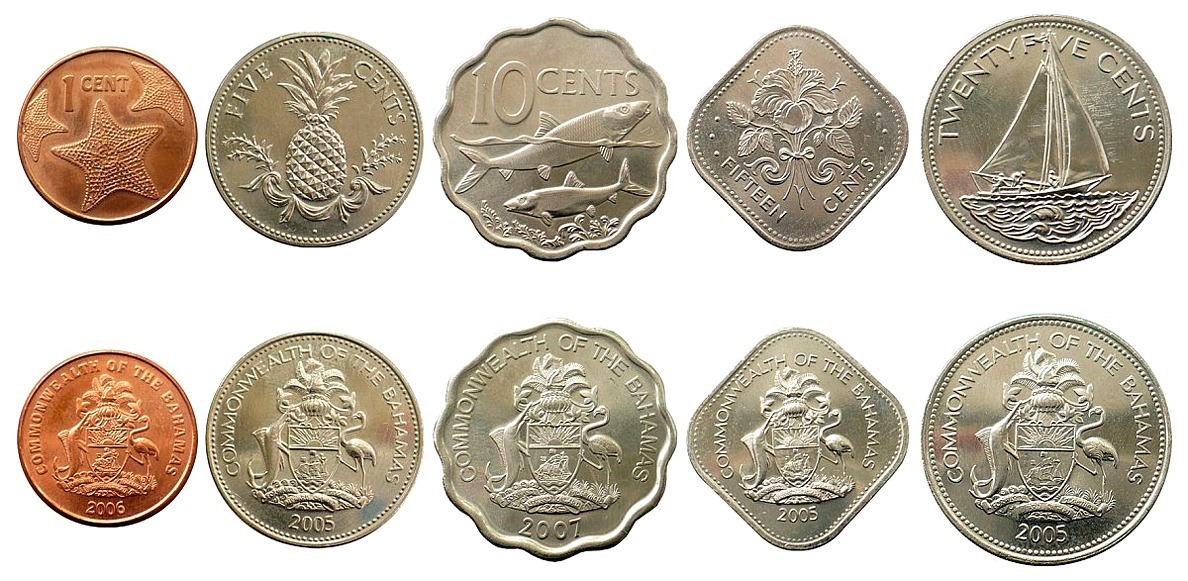
The obverse of all coins is the same - the coat of arms of the Commonwealth of the Bahamas.
As for mainland North America, I did not manage to find here curious copies of regular issue coins. Therefore, I propose to move further to the shores of Australia.
But along the way look at the Cook Islands. Like many island countries' currencies, the money of this public entity - the Cook Islands Dollar - is rather unusual. In the course of the coin face value of 1, 2 and 5 dollars, 10, 2 and 50 cents. Cent coins were withdrawn from circulation in 2006. But in 2015, on the anniversary of the 50th anniversary of the Independence of the Cook Islands, a new series of everyday coins was issued.

On the obverse is a portrait of the ruling Queen of Great Britain Elizabeth II. On the reverse of coins of different denominations - an image of an orange fruit with leaves flying and sitting on a tern branch, floating in water of tuna, figures of Tangaroa - the Polynesian god of the sea, cumet - a traditional table and waka - a traditional sailing boat.
The islands are also used New Zealand dollar. But the design of these coins is nothing remarkable.
Frankly, and Australian coins (Australian dollar), not many will be able to recognize interesting. But what a world tour without Australia?
On the obverse is a portrait of Queen Elizabeth II. On the reverse - the image of animals inhabiting the continent: echidna, lyrebird, platypus, kangaroo; the coat of arms of Australia (coin of 50 cents) and the head of the Australian aborigine (coin of 2 dollars).
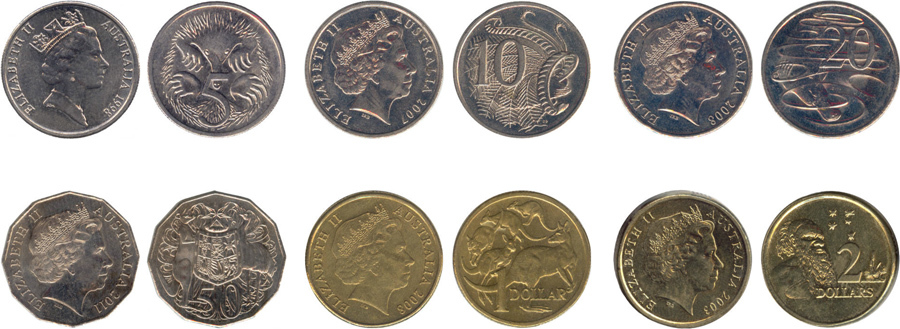
Modern yen minted from aluminum, brass, bronze and nickel silver. There are coins of 1, 5, 10, 50, 100 and 500 yen in circulation. The holes in the middle of some coins (5 and 50 yen) - stylized ancient and medieval coins. Holes were made so that coins could be worn strung on a cord. This was especially true in countries where the folk costume did not imply pockets (Japan was one of them). All that was necessary to carry around with them, the Japanese clung to their belts, and the string with coins was usually hidden under it. In addition, the hole in the coin allowed to reduce the cost of its manufacture and protect against fakes.
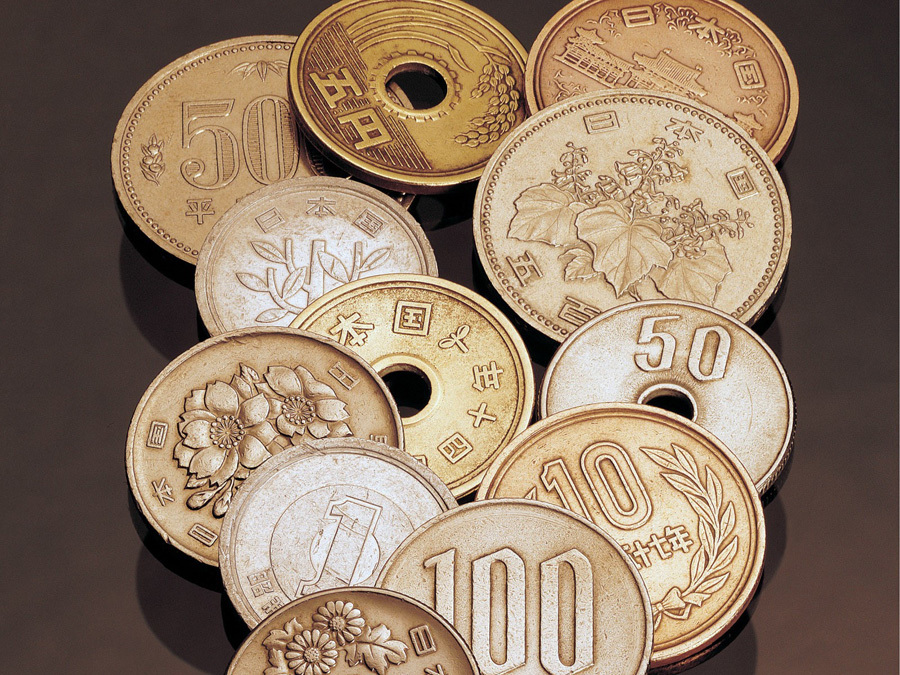
Another feature of Japanese coins is that the year of the emperor's reign, at which it was issued, is indicated instead of the year of issue on the coins. For example, the coin of 2006 will have a date Heisei 18 (reign of Emperor Akihito).
On this our world tour came to an end. In addition to its main monetary function, coins keep a part of the history of states that we witnessed during our virtual tour. If we had covered all this distance in reality, such a journey from Russia to Japan (about 45 thousand km) would have taken 60 hours of uninterrupted flight. And taking into account transfers and scheduled connections at least a week.
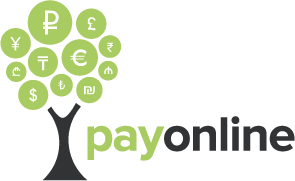
Did we find something special, judge you. We only note that this review is not a rating and is based on the personal preferences of members of the editorial board. The starting point of our journey will be Russia. For clarity, the route of movement, we mapped.
Issue 1. How did world currencies get their names?
Issue 2. Rating of the most beautiful money of the world
Issue 3. Composite coins - an alternative to paper and metal
Release 4. Money of the XX century: a selection of bills, out of circulation
Issue 5. Around the World for money symbols: a selection of interesting coins from around the world
')
Russia
How Russian coins look, every Russian knows. But, perhaps, not everyone has heard that this year the Bank of Russia issued coins with an updated obverse. Earlier in the design was used the emblem of the Bank of Russia. The minting of coins with the image of an eagle without regalia began in 1992, when the national emblem of Russia was not yet approved.
On the new coins of all denominations, the Central Bank’s emblem replaced the image of the state emblem of the Russian Federation (this is a regular coinage, the emblem on commemorative coins could be seen earlier, for example, in the series devoted to the Sochi Olympics) - a double-headed eagle with regalia of power: crowns, a scepter and power. One such literally the other day came into my hands (on the left there is a coin with an old obverse, on the right - with a new one)

In my opinion, now the coin looks more elegant. Coins with an old obverse ("eagle") remain in circulation and "continue to be legal means of cash payment."
By the way, the national designation of the sides of the coin - “tails”, according to one of the versions, is associated with the advent of copper coins of the Empress Elizaveta Petrovna. The patterned interlacing of the royal initials was perceived by the illiterate population as a lattice.

But let's not delve into the story, we begin our journey. And first I propose to visit Denmark.
Denmark
As a warm-up, consider the design of Danish coins, by the way, rather unusual for a European country.

The photo shows coins 50 era, 1, 2, 5, 10 and 20 CZK. Coins in denominations of 1, 2 and 5 CZK with a hole in the center began to be issued since 1925 in order to simplify the life of the visually impaired. For the same reason, such coins are minted today. Holes differ in diameter, so they are very easy to distinguish.
Another interesting detail of Danish coins is the “hearts” in different parts of the coins. Such an unusual symbol is the sign of the Danish Mint. On coins of 50 era, 1, 2, 5 kronor, hearts are more noticeable, on coins of 10 and 20 kroner they are also present, but not so obvious and are located only on the obverse - among the inscriptions.
Great Britain
In the United Kingdom you can find coins of such denominations: 1, 2, 5, 10, 20, 50 pence, as well as 1 and 2 pounds. On the obverse of British coins traditionally depict the current monarch (now - a portrait of Queen Elizabeth II). As the queen ages, the portrait has changed, and now there are 4 different profile types:

Each subsequent royal person looks in the opposite direction to the previous one. The reverses of British coins are quite diverse. Until 2008, the Penns reverse depicted various symbols of the United Kingdom - the crowned porticulis (a descending lattice in the gates) of the Westminster Palace, a fragment of the coat of arms of Wales (3 ostrich feathers over the princely crown), the emblem of Scotland (the crown above the burdock flower) and others.
Since 2008, on the reverse of pennies, fragments of the shield of the royal coat of arms of Great Britain were depicted, and on the new pound coin - the entire shield.
The latter, by the way, actually has no fixed reverse. Since the introduction of the one-pound coin in its current form in 1983, the reverse has changed annually (and sometimes twice a year). Each year, it places something corresponding to one of the 4 parts of the Kingdom - England, Northern Ireland, Wales and Scotland - plants representing parts of Great Britain - oak, flax, leek, thistle; heraldic elements - a rising lion, a walking dragon, a Celtic cross; famous bridges; fragments of coats of arms and others. Here are just some of the pound coins:

All of them are in circulation, which makes British numismatics rather difficult and costly.
Egypt
But in Egypt, on the contrary, a set of coins of regular coinage is quite limited. In the course of the coin in denominations of 25, 50 piastres and 1 pound. Two more - 5, 10 piastres, although they are legal means of payment, but practically do not occur in circulation.

The obverse of the coins (with the exception of 25 piastres) shows thematic pictures: a vase in classical Arabic style, the mosque of Mohammed Ali, which is located in the Cairo citadel, a portrait of Cleopatra, the funerary mask of Tutankhamun. 25 piastres — perhaps the most uninteresting of Egyptian coins — contain only inscriptions — the denomination and name of the state جمهورية مصر العربية (“Arab Republic of Egypt”). On the reverse of all coins - denomination in Arabic and in English.
Suriname
The next country we go to is Suriname, a state in northeastern South America. Local coins are primarily interesting face value. In the course of 1, 5, 10, 25, 100 and 250 cents.
On the obverse of the coins in the frame of floral ornament is the coat of arms of Suriname. On the coat of arms you can see two indigenous people holding a central shield. His left half with the image of the ship symbolizes the past, when slaves from Africa were brought to Suriname. The right side personifies the present, depicted as a palm tree (the symbol of a righteous person). The rhombus in the center of the shield indicates 4 directions of the world, and the five-pointed star - 5 continents and 5 large ethnic groups that make up the population of Suriname.
On the background of coins with a standard round shape, coins of 5 cents stand out - they are square, their corners are smoothly rounded.
Curacao and Sint Maarten
Curaçao and Sint Maarten are self-governing public entities - 2 islands that are part of the Kingdom of the Netherlands . The Netherlands Antillean guilder, introduced into circulation in 1932, is recognized as the national currency. In 2012, the islands planned to switch to the Caribbean guilder, but after the introduction of the new currency was postponed indefinitely.
Almost all the coins of Curacao and Sint Maarten have a regular round shape. The only exception is a coin of fifty cents, made in the shape of a tetrahedron.
All cent coins have a similar design and embossing. On the reverse invariably minted face value in a circle with an ornament of sea shells and pearls. On the obverse - an orange branch with three flowers.
The reverse of the coins of 1, 2, 2.5 and 5 guilders shows the old coat of arms of the Netherlands Antilles. On the obverse is the profile of Queen Beatrix of the Netherlands.
Bahamas
We fly further. In the course of the Bahamas. In circulation coins of 1, 5, 10, 15 and 25 cents. Bahamas coins have an unusual shape and a rather exotic design: on the reverse of the coins, depending on the denomination, you can find an image of a starfish, a pineapple, two mackerel in water, a hibiscus flower, a sailing boat.

The obverse of all coins is the same - the coat of arms of the Commonwealth of the Bahamas.
As for mainland North America, I did not manage to find here curious copies of regular issue coins. Therefore, I propose to move further to the shores of Australia.
Cook Islands
But along the way look at the Cook Islands. Like many island countries' currencies, the money of this public entity - the Cook Islands Dollar - is rather unusual. In the course of the coin face value of 1, 2 and 5 dollars, 10, 2 and 50 cents. Cent coins were withdrawn from circulation in 2006. But in 2015, on the anniversary of the 50th anniversary of the Independence of the Cook Islands, a new series of everyday coins was issued.
On the obverse is a portrait of the ruling Queen of Great Britain Elizabeth II. On the reverse of coins of different denominations - an image of an orange fruit with leaves flying and sitting on a tern branch, floating in water of tuna, figures of Tangaroa - the Polynesian god of the sea, cumet - a traditional table and waka - a traditional sailing boat.
The islands are also used New Zealand dollar. But the design of these coins is nothing remarkable.
Australia
Frankly, and Australian coins (Australian dollar), not many will be able to recognize interesting. But what a world tour without Australia?
On the obverse is a portrait of Queen Elizabeth II. On the reverse - the image of animals inhabiting the continent: echidna, lyrebird, platypus, kangaroo; the coat of arms of Australia (coin of 50 cents) and the head of the Australian aborigine (coin of 2 dollars).
Japan
Modern yen minted from aluminum, brass, bronze and nickel silver. There are coins of 1, 5, 10, 50, 100 and 500 yen in circulation. The holes in the middle of some coins (5 and 50 yen) - stylized ancient and medieval coins. Holes were made so that coins could be worn strung on a cord. This was especially true in countries where the folk costume did not imply pockets (Japan was one of them). All that was necessary to carry around with them, the Japanese clung to their belts, and the string with coins was usually hidden under it. In addition, the hole in the coin allowed to reduce the cost of its manufacture and protect against fakes.

Another feature of Japanese coins is that the year of the emperor's reign, at which it was issued, is indicated instead of the year of issue on the coins. For example, the coin of 2006 will have a date Heisei 18 (reign of Emperor Akihito).
On this our world tour came to an end. In addition to its main monetary function, coins keep a part of the history of states that we witnessed during our virtual tour. If we had covered all this distance in reality, such a journey from Russia to Japan (about 45 thousand km) would have taken 60 hours of uninterrupted flight. And taking into account transfers and scheduled connections at least a week.

Source: https://habr.com/ru/post/399269/
All Articles